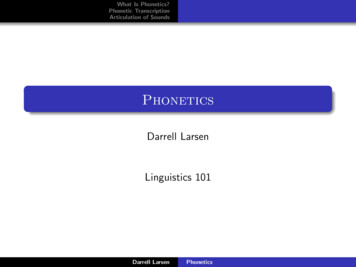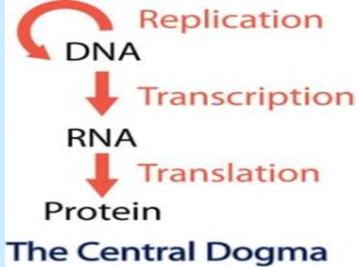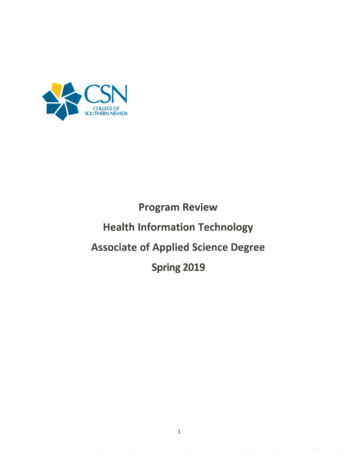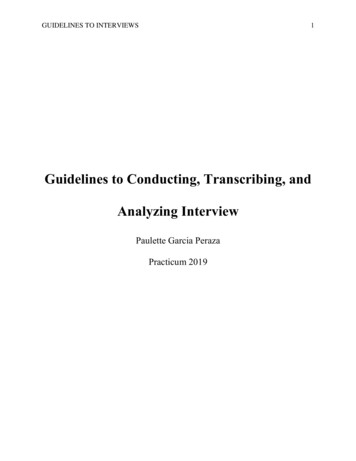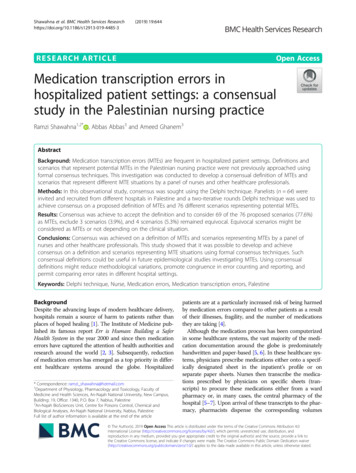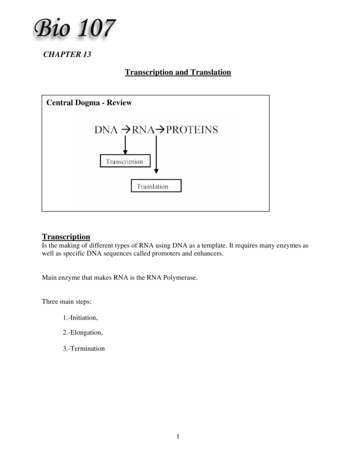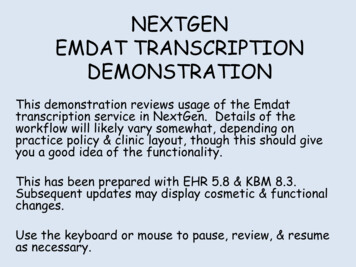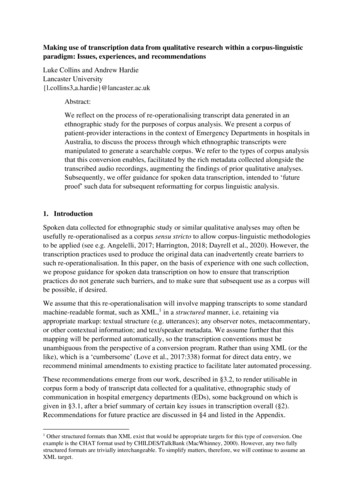
Transcription
Making use of transcription data from qualitative research within a corpus-linguisticparadigm: Issues, experiences, and recommendationsLuke Collins and Andrew HardieLancaster tract:We reflect on the process of re-operationalising transcript data generated in anethnographic study for the purposes of corpus analysis. We present a corpus ofpatient-provider interactions in the context of Emergency Departments in hospitals inAustralia, to discuss the process through which ethnographic transcripts weremanipulated to generate a searchable corpus. We refer to the types of corpus analysisthat this conversion enables, facilitated by the rich metadata collected alongside thetranscribed audio recordings, augmenting the findings of prior qualitative analyses.Subsequently, we offer guidance for spoken data transcription, intended to ‘futureproof’ such data for subsequent reformatting for corpus linguistic analysis.1. IntroductionSpoken data collected for ethnographic study or similar qualitative analyses may often beusefully re-operationalised as a corpus sensu stricto to allow corpus-linguistic methodologiesto be applied (see e.g. Angelelli, 2017; Harrington, 2018; Dayrell et al., 2020). However, thetranscription practices used to produce the original data can inadvertently create barriers tosuch re-operationalisation. In this paper, on the basis of experience with one such collection,we propose guidance for spoken data transcription on how to ensure that transcriptionpractices do not generate such barriers, and to make sure that subsequent use as a corpus willbe possible, if desired.We assume that this re-operationalisation will involve mapping transcripts to some standardmachine-readable format, such as XML,1 in a structured manner, i.e. retaining viaappropriate markup: textual structure (e.g. utterances); any observer notes, metacommentary,or other contextual information; and text/speaker metadata. We assume further that thismapping will be performed automatically, so the transcription conventions must beunambiguous from the perspective of a conversion program. Rather than using XML (or thelike), which is a ‘cumbersome’ (Love et al., 2017:338) format for direct data entry, werecommend minimal amendments to existing practice to facilitate later automated processing.These recommendations emerge from our work, described in §3.2, to render utilisable incorpus form a body of transcript data collected for a qualitative, ethnographic study ofcommunication in hospital emergency departments (EDs), some background on which isgiven in §3.1, after a brief summary of certain key issues in transcription overall (§2).Recommendations for future practice are discussed in §4 and listed in the Appendix.1Other structured formats than XML exist that would be appropriate targets for this type of conversion. Oneexample is the CHAT format used by CHILDES/TalkBank (MacWhinney, 2000). However, any two fullystructured formats are trivially interchangeable. To simplify matters, therefore, we will continue to assume anXML target.
2. Contrasting approaches to transcriptionTranscription processes are ‘variable’, significantly influenced by the intended analysis or‘research function’ (Bucholtz, 2007). In studies of spoken discourse, there is broadly adistinction between (a) Conversation Analysis (CA) transcripts, which capturephonetic/prosodic aspects of speech, e.g. intonation and allophony (typically via the highlyinfluential Jeffersonian system: Jefferson, 1983); and (b) orthographic transcripts, whichcapture little phonetic detail and therefore are suited to investigations into ‘morphology, lexis,syntax, pragmatics, etc.’ (Atkins et al., 1992:10). Of course, it is possible forphonetic/prosodic detail to be added to orthographic transcripts to support CA, as Rühlemann(2017) has shown with the British National Corpus (BNC) 1994.Since both spoken corpus construction and transcription for ethnographic analysis aretypically orthographic-only, they are thus compatible in principle. Furthermore, qualitativeand/or ethnographic transcription data typically includes rich metadata on speakers andcommunicative contexts, the lack of which has been a criticism of corpus analysis; theinconsistent availability of speaker metadata has been raised as a limitation of the BNC1994(Lam, 2009) for example. Clearly, then, conversion of transcriptions collected for qualitativeresearch to corpus data should preserve, and make usable, all contextual metadata.3. A case study: Communication in Emergency Departments3.1. The original dataThe collection of transcripts by the Communication in Emergency Departments project, ledby Diana Slade, ANU Institute for Communication in Health Care, was for the purpose of astudy combining ‘discourse analysis of authentic interactions between clinicians and patients;and qualitative ethnographic analysis of the social, organisational, and interdisciplinaryclinician practices of each department’ (Slade et al., 2015: 11). Slade et al. (2015: 1-2)describe this data as consisting of:communication between patients and clinicians (doctors, nurses and allied healthprofessionals) in five representative emergency departments in New South Wales andthe Australian Capital Territory. The study involved 1093 h of observations, 150interviews with clinicians and patients, and the audio recording of patient–clinicianinteractions over the course of 82 patients’ emergency department trajectories fromtriage to disposition.This ‘patient journey’ dataset comprises 1,411,238 tokens and supported ‘one of the mostcomprehensive studies internationally on patient-clinician communication in hospitals’ (Sladeet al., 2015: 2). One major application for such data is in investigations into ‘criticalincidents’ (avoidable patient harm), in which poor health outcomes may be attributable tocommunication problems. In such cases, typically no record of these problems is availablewhen the health outcomes are investigated, often months after the event.The transcription of the data was orthographic, showing consideration for topics that any suchscheme must address – data protection/anonymisation; the structure of talk (utterance
overlaps); unclear material; non-standardised forms; transcriber notes. These were recordedas follows:We have transcribed clinician–patient interactions using standard English spelling.Nonstandard spellings are occasionally used to capture idiosyncratic or dialectalpronunciations (e.g. gonna). Fillers and hesitation markers are transcribed as they arespoken, using the standard English variants, e.g. Ah, uh huh, hmm, mmm.What people say is transcribed without any standardisation or editing. Nonstandardusage is not corrected but transcribed as it was said (e.g. me feet are frozen).Most punctuation marks have the same meaning as in standard written English. Thosewith special meaning are: indicates a trailing off or short hesitation. means overlapping or simultaneous talk [ ]—indicates a speaker rephrasing or reworking their contribution, often involvingrepetition [ ][words in square brackets] are contextual information or information suppressed forprivacy reasons. Examples:[Loud voices in close proximity] contextual informationZ1 And your mobile number I’ve got [number].(words in parentheses) were unclear but this is the transcriber’s best analysis.( ) empty parentheses indicate that the transcriber could not hear or guess what wassaid [ ](Slade et al., 2015:xi)The transcripts are accompanied by metadata about each participant (role, gender, age,language background, nationality) and headed with information on the context of the ‘patientjourney’ (presenting illness, diagnosis, duration of visit, triage level, number of healthprofessionals seen, and researcher notes).While Slade et al. (2015:19) present ‘information-rich description and analysis’, theyinevitably explore relatively few instances of interaction in close detail. Given the data’sextent, corpus-based techniques can clearly enhance the analysis of (in)effective clinicianpatient interaction using this resource. The team working towards this end2 utilises LancasterUniversity’s CQPweb server (see Hardie, 2012) as its primary analysis platform. As a firststep, it was necessary to convert this ED Corpus to an XML-based format (for subsequenttagging and indexing) along with structured metadata usable within CQPweb (i.e. not freeprose metadata). We turn now to the processes involved in this conversion, and problems2This undertaking is a collaboration between the Emergency Communication research team, now basedprimarily at the University of Technology, Sydney Australian National University, Institute for Communicationin Health Care (ICH); and the ESRC Centre for Corpus Approaches to Social Science (CASS) at LancasterUniversity.
arising from the original transcription practice (which, obviously, could not have beenanticipated).3.2. Corpus conversionThe transcripts were created, and initially analysed, using Microsoft Word. We used a twostep process to generate usable corpus data. First, the documents were exported to HTMLusing the relevant Word function (scripted to run automatically across multiple documentsusing Microsoft’s Visual Basic for Applications). Plain text export would lose most if not allof the formatting that indicates document structure; HTML export retains this information,albeit not in a form usable by corpus software. Therefore, the second step was to use abespoke text-conversion script3 to (a) simplify Word-output HTML in order to (b) parse thedocument for metadata and utterance content which is then (c) reformatted into XML (per therecommendations of Hardie, 2014). This script also identified unparsable regions of thecontent, helping us iteratively extend the script to handle them. Our goal was to avoid manualediting while retaining as much information as possible. Achieving this was complicated bytwo issues: ambiguity and inconsistency.Ambiguity arises from the use of the same form of notation to represent functionally differentcontent. In the ED Corpus, square brackets were used for ‘contextual information orinformation suppressed for privacy reasons’ (Slade et al., 2015). A human reader able todiscern intent can easily tell which of three functions (anonymisation, recording non-speechsounds, transcriber comments) applies. A computer cannot. To represent each functional typeof information distinctly in the corpus, we had to disambiguate use of square brackets, byautomatically compiling a list of instances of square-bracketed text and then coming up with,and coding as regular expression tests, rules to distinguish anonymised speech fromtranscriber comments (etc.).This process made it apparent that square brackets were also usedto code embedded turns: short turns not represented as separate utterances but rather as eventswithin the utterance of another speaker. Most utterance breaks in the original documents areindicated by the start of a new table-row. This representation was used largely for instancesof backchannelling (Yngve, 1970:568) as follows:PNo. Just this – just this morning, in the – in the night. I know it coming, thephlegm black. [D Mm mm] No more.This information about backchannelling disrupts the organisation of utterance boundaries,which are essential for automatic identification of speech by specific (kinds of) speakers.Merging this representation with normally-encoded utterance breaks was therefore a priority.But this was hindered by the embedded turns’ ambiguity with the three square-bracketfunctions already discussed. Not even the speaker ID incipit (‘D’ above) distinguishesembedded turns, since transcriber comments can also have this form, e.g. [D examinespatient]. Disambiguating this required both automatic checks (for obvious backchannelcontent like mm mm) and manual effort to list all non-obvious cases.3Any scripting language (Python, Ruby, Perl, etc.) is suitable for this purpose; we used PHP. The script is basedon regular expression search-and-replace to translate existing features of the textual format to XML and is, thus,computationally trivial; its writing required detailed knowledge of the data, and it is thus specific to this corpusand not reusable (though of course the general technique is applicable, and has been applied, to other datasets).
Inconsistency is present in multiple aspects of transcribers’ practice, including use ofpunctuation, and the descriptive wording within different types of notes. Some variantpractice (for instance, use of round vs. square brackets) actually violated the guidelines. SinceSlade et al.’s (2015) subsequent qualitative analysis was not impeded, such inconsistencyevidently poses no problem for humans. However, corpus methods rely ‘on the recurrence ofconsistent representations of linguistic phenomena’ (Adolphs and Carter 2013: 155), i.e.representations that a computer can recognise as identical. Keeping each transcriberconsistent with others’ practice, and with their own over time, is not easy. Expanding thedetail in the transcription scheme is no answer, since doing so increases the time needed fortranscription (and thus the cost), and in fact makes it harder to maintain inter- and intratranscriber consistency (see Love et al., 2017).With respect to square-bracket-marked anonymisation alone we observed over 120 differentways of representing omitted names, including: Simple placeholder: [name]Postmodification expressing role: [Name of researcher], [Name of Father], [Name offemale nurse]Speaker ID codes: [name of N2], [D1]Premodification narrowing reference: [Male name], [Middle Name Last Name]Various representations of spelt name: [Spells out name], [S-U-R-N-A-M-E]Commentary on editorial or speaker naming act: [name removed], [gives first nameonly].Such inconsistency is not purely negative; some of the above represents transcribers’ creativeexploitation of the tool at hand (square brackets) to encode contextual information nototherwise available to the reader, such as roles and relations of the person mentioned (whichotherwise are opaque after anonymisation). Yet still it generated obstacles to conversion intoautomatically manipulable corpus format. Direct links exist between the informationextracted from the transcripts and specific query tools in CQPweb, as follows (other softwarepresents intersecting but not identical sets of affordances):4 Information on speakers alongside clear (XML-format) utterance boundaries:CQPweb can restrict queries to utterances of speakers with particular metadatafeatures (e.g. sex, age, or more relevantly role as patient, doctor, nurse, etc.),4 as wellas generate statistical comparisons (e.g. keywords) between subcorpora delineated bythis information. Information on contextual features: CQPweb can treat each interaction as a ‘text’, andcontextual information as text-level metadata, enabling division of the corpus by thesefactors (such as timing of different stages of the recorded ‘patient journey’) as well as,or instead of, speaker features. Anonymisation and vocalisation labels: if consistent, these can be located usingCQPweb’s query syntax, allowing, for instance, language use in the vicinity ofHardie (forthcoming) explains the systems used within CQPweb to accomplish this.
laughter, or contexts where personal information is expressed at high density (and soon), to be identified and studied.Our experience has been that enriching the corpus with the non-textual information within theoriginal transcription enables analysts to engage with both the ‘broad and local sense ofcontext’ (Cicourel, 2014: 377) and thus bring corpus and ethnographic approaches closertogether. We were thus driven to reflect on how the barriers to this kind of work might belowered for a wide range of scholars. Problems of transcriber inconsistency and ambiguityare not insuperable, but are an impediment. We thus proceed to recommend slightmodifications to transcriber practice in qualitative/ethnographic research that would make theresulting dataset more easily usable as a corpus down the line. Being based on work with asingle dataset, these recommendations may not address facets of the problem at hand thatmight emerge in other circumstances. Nevertheless the facets they do address are sufficientlygeneric to assure at least some wider applicability.4. Recommendations4.1. Orthographic consistencyWe see no upside to recommending changes in transcription practices substantial enough toimpede the initial purpose of qualitative data transcription. Instead, we suggest tweaks toexisting practice to ‘future-proof’ such datasets so that their subsequent use within a corpuslinguistic paradigm is facilitated: by enhancing consistency, reducing ambiguity, and therebymaking data conversion more straightforward and reliable.On the consistency front, the key is to minimise what Andersen (2016) calls ‘unmotivatedvariability’ in transcription (reproduction of actual variation in the language beingrepresented is motivated and of research interest, of course). The items potentially affectedare largely those lexicalised forms and semi-lexicalised forms (Andersen, 2016) for whichthere is some orthographic convention but no strong standard. Colloquial pronunciationsoften have multiple potential orthographic representations, as do vocalised or filled pauses(um, erm, uh, and friends). Atkins et al. (1992) recommended establishing a closed set ofnon-standard forms that transcribers are permitted to use, and this remains best practice.Without such limits, it is impossible to know whether word-forms er, uh, ehhhn (etc.)represent phonetically different vocalisations, or whether there is a real distinction betweenthe weak-form of have represented as of versus ’ve, without listening to the recording. A pilotstage may be required to understand exactly what kind of variation transcribers need, and areable, to utilise consistently, as demonstrated by recent work on spoken corpus creation (Loveet al., 2017; Gablasova et al. 2019). Establishing a closed set reduces (but does not eliminate)the scope for inter- and intra-transcriber inconsistency.4.2. Unambiguous markup of non-speech materialTo limit, and if possible eliminate, ambiguity of notation, we recommend that theconventions should present clearly distinct representations for distinct kinds of comment orlabel, all of which must also be unambiguously distinct from actual spoken content. This ispartly accomplished by Slade et al.’s (2015) system (see §3.1), which mandates use of round
brackets to mark spoken content as unclear, in contrast to the square brackets’ functions. Inpractice, this distinguishes:1. They asked me my (name?)2. [name] is here to see you.In (1), the speaker has said name, but the speech is unclear (perhaps because of audibilityissues); the round brackets and question mark express the transcriber’s uncertainty. In (2), thespeaker has used some person’s actual name; the square-bracketed label records and classifiesthe redaction. This represents good practice but not best practice, as under these guidelinesmultiple distinct kinds of insertion are delimited by square brackets (vocalisations, transcribercomments, embedded utterances, and redactions for privacy), and this proved a substantialimpedance to corpus conversion. Recording functionally distinct information types inunambiguously distinct forms requires only a minor adjustment to transcription practice.We suggest that different uses of square brackets should be indicated by a flag characterdirectly after the opening square bracket, with the same principle applied to round brackets ifthey have multiple uses. Individual punctuation characters such as number-sign/hash (#), atsign (@), colon or semi-colon are recommended,5 since transcribers are unlikely to beginbracketed material with any of these and each flag expresses directly what the square bracketsrepresent, e.g.: Vocalisation: [@laughs]Transcriber comment: [#D fills in form]Embedded utterance: [ P yeah]Redaction: [name]The presence of flags in the original transcript will not impede manual analysis, but doesmake it entirely mechanistic to automatically convert the above to XML or another structuredformat, for instance: [@laughs] becomes voc desc "laughs"/ [#D fills in form] becomes comment content "D fills in form"/ [ P yeah] becomes u who "P" trans "overlap" yeah /u [name] becomes anon type "person"/ The precise flags used can be adjusted per the requirements of any particular data collectionor corpus conversion endeavour. The example XML above was devised in light of ourparticular needs: (a) to have this non-textual information accessible via CQPweb, into whichnon-linguistic data can only be input in the form of simple pseudo-XML tags; (b) to excludefrom corpus queries and word counts the content of sometimes lengthy non-speech materialin transcriber comments. Since CQPweb models text as a sequence of tokens, where XMLtakes up no space, but sits between tokens, we generate a dummy token unmistakeable forany real word, i.e. anon --anonname /anon (where --anonname need only beunmistakeable for any real word) to allow redacted word(s) to take up space in the token5To avoid complications, it is better not to use as a flag any symbol with a special meaning in regularexpression syntax, since most query engines interpret these in special ways. This includes question mark, plus,asterisk, circumflex, and dollar-sign.
sequence. The ability to vary the data representation via automatic conversion is a furtheradvantage of the adjusted practices we suggest.4.3. Standardised values and commentsSearchability and countability of redactions, vocalisations and the like are further enhanced iftheir descriptions, the material within the brackets, are presented in regular form. Frequent inour corpus are vocalisations ‘laughter’ and ‘coughing’, features relevant to the research aims(e.g. analysing, respectively humour and rapport-building/illness and audibility). However,the transcribers variously use nouns, plain verbs and third-person verbs to code these:[laughter], [laugh] and [laughs] all occur. We recommend that transcriber practice shouldstandardise on just one style, e.g. [@laughs], [@coughs]. Ideally, a closed list of permissiblevocalisation descriptions should be defined.The same principle applies to redactions. Using the standardised format [name], other typesof anonymised information (e.g. dates of birth, telephone numbers) can be given definedlabels from a restricted set. For some projects, a single category for all proper nouns mightsuffice; in other cases, separate labels for [name], [place], [organisation], might be needed.As an extension, ID codes for speakers can be permitted, for mentions of catalogueddiscourse participants, e.g. [P], [D2]. These can be automatically recognised, and used tocreate an anon/ which records who has been mentioned, e.g. as anon type "person"who "D2"/ . Finally, the same closed-list approach should be applied to categorical valuestaken by metadata on texts or speakers, so that it may be automatically extracted in structuredform.Using closed lists has the disadvantage of denying transcribers freedom to record on theirown initiative relevant but non-predefined information. For example, a transcriber might wishto record an anonymisation as [name of patient’s mother] to aid analysts’ understanding ofthe text, but our recommendations would require just [name]. To counteract this, werecommend the non-standardised comment mechanism, that is [#text-of-comment], wherecomments directly after some other element are understood by convention to relate to it:[name][#patient’s mother]. In the same way, vocalisation descriptors can be enhanced in anadjacent comment, e.g. [@coughs][#to draw doctor’s attention], to support subsequentinvestigations of form or function. We strongly suggest not limiting use of comments in anyway, retaining this one notation as a highly flexible space for any contextual information thetranscriber thinks pertinent.Finally, we recommend a fairly informal approach to silences. Transcribers should not betasked with precise measurements of pauses. In the ED transcripts, ellipses were used foreither a pause or the trailing-off of an utterance. We recommend that ellipses be restrictedto indicating a discernible pause of less than (roughly) three seconds, for use within a turn,not at the end. For silences of three to ten seconds, we suggest the convention [pause], andfor prolonged silences of more than ten seconds, the convention [silence]. These latter twoconventions are not ambiguous with redactions because pause/silence are not types ofanonymisation.5. Conclusion
The above recommendations are designed to generate minimal ambiguity when qualitativeresearch transcription data is mapped to XML or other structured format and operationalisedas a searchable corpus. The Appendix presents their implementation as modifications toSlade et al.’s (2015) conventions; however, what we really wish to underline are theadvantages in principle of conventions that are utterly unambiguous, and thus manageable bycomputer programs.6 Defining and enforcing such conventions simplifies and regularisestranscription, while permitting rich contextual information via the flexible transcribercomment mechanism.AcknowledgementsThis research was supported in part by the Economic and Social Research Council, grantreference ES/R008906/1, ESRC Centre for Corpus Approaches to Social Science (CASS).Appendix: Summary of recommendationsNon-standard variants, filled pauses, and weak forms should not be transcribedimpressionistically. Rather, researchers should pre-define a closed set of allowed lexical andsemi-lexical items of these kinds, based on considerations of conventionalised orthography(e.g. erm, dunno) and of the range of variation present in the data and pertinent to theirresearch interests.Punctuation use should be minimal. Question and exclamation marks may be left to thetranscriber’s intuition regarding whether intonation cues require them (rather than explicitinterrogative/exclamative forms).(word?)Round brackets/parentheses should indicate a transcriber’s best guess atunclear words on the recording; an optional question mark can indicateespecially uncertain guesses; and empty brackets ( ) a totallyuninterpretable word(s).[name]Square brackets with no flag should indicate content that has beenredacted (with a label such as name, place, dateofbirth, as appropriate)[#comment]Square brackets flagged with hash should indicate transcriber comments:any observations, interpretations or descriptions that are not actualrecorded speech.[@laughs]Square brackets flagged with @ should indicate vocalisations (with alabel such as laughs, coughs, groans ) that occur within an utterance. Short pause: less than three seconds.[pause]Medium pause: 3-10 seconds.[silence]Long pause: anything more than 10 seconds.Unambiguous markup also makes possible automated detection of mistakes made in transcribers’ use ofbrackets and other notation; we lack space to explore this issue in detail, however.6
Onset of a turn which overlaps the prior turn.ReferencesAdolphs, S. and Carter, R. 2013. Spoken Corpus Linguistics – From Monomodal toMultimodal. London: Routledge.Andersen, G. 2016. ‘Semi-lexical features in corpus transcription: Consistency,comparability, standardisation’, International Journal of Corpus Linguistics 21(3), pp 323347.Angelelli, C. V. 2017. ‘Can ethnographic findings become corpus-studies data? Aresearcher’s ethical, practical and scientific dilemmas’, The Interpreter’s Newsletter 22, pp 115.Atkins, A., Clear, J. and Ostler, N. 1992. ‘Corpus design criteria’, Literary and LinguisticComputing 7(1) pp 1–16.Bucholtz, M. 2007. ‘Variation in transcription’, Discourse Studies 9(6), pp 784-808.Cicourel, A. V. 2014. ‘The interpenetration of communicative concepts: examples frommedical encounters’, in H. E. Hamilton and W.-Y. S. Chou (eds.) The Routledge Handbookof Language and Health Communication, pp 375-388. London: Routledge.Dayrell, C., Ram-Prasad, C. and Griffith-Dickson, G. 2020. ‘Bringing corpus linguistics intoReligious Studies: Self-representation amongst various immigrant communities with religiousidentity’, Journal of Corpora and Discourse Studies 3, pp 96-121.Gablasova, D., Brezina, V. and McEnery, T. 2019. ‘The Trinity Lancaster Corpus:Development, description and application’, International Journal of Learner CorpusResearch 52, pp 126-158.Hardie, A. 2012. ‘CQPweb – Combining power, flexibility and usability in a corpus analysistool’, International Journal of Corpus Linguistics 17(3) pp 380-409.Hardie, A. 2014. ‘Modest XML for Corpora: Not a standard but a suggestion’, ICAMEJournal 38, pp 73-103.Hardie, A. Forthcoming. ‘Managing complex and arbitrary corpus subsections at scale and atspeed: from formalism to implementation within CQPweb’.Harrington, K. 2018. The Role of Corpus Linguistics in the Ethnography of a ClosedCommunity: Survival Communication. New York: Routledge.Jefferson, G. 1983. ‘Issues in the Transcription of Naturally-occurring Talk: Caricature vs.Capturing Pronunciational Particulars’, Tilburg Papers in Language and Literature 34.Available at: ature.pdf.Lam, P. 2009. ‘The making of a BNC customised spoken corpus for comparative purposes’,Corpora, 4(1), pp 167-188.
Love, R., Dembry, C., Hardie, A., Brezina, V. and McEnery, T. 2017. ‘The SpokenBNC2014: Designing and building a spoken corpus of everyday conversations’, InternationalJournal of Corpus Linguistics, 22(3), pp 319-344.MacWhinney, B. 2000. The CHILDES Project: Tools for Analyzing Talk. 3rd Edition.Mahwah, NJ: Lawrence Erlbaum.Rühlemann, C. 2017. ‘Integrating Corpus-Linguistic and Conversation-AnalyticTranscription in XML: The Case of Backchannels an
2. Contrasting approaches to transcription Transcription processes are 'variable', significantly influenced by the intended analysis or 'research function' (Bucholtz, 2007). In studies of spoken discourse, there is broadly a distinction between (a) Conversation Analysis (CA) transcripts, which capture
